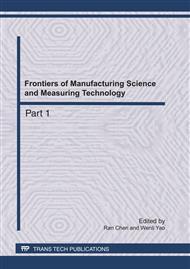p.872
p.877
p.884
p.888
p.892
p.896
p.900
p.905
p.910
Solid-Phase Extraction Method for Preconcentration/Separation of Zinc Ion in Tap Water and Human Urine Using Organo-Bentonite Modified by Dithizone
Abstract:
A new method was proposed for the preconcentration/separation of zinc at trace levels using a modified organo-bentonite with dithizone (D-O-bentonite) and determined by flame atomic absorption spectrometry (FAAS). The influences of some experimental parameters including pH of the sample solution, contact time, and volume of eluent have been investigated. The influences of some matrix elements were also examined. The results show that the zinc ion could be adsorbed on the D-O-bentonite. The adsorbed quantitively was affected by the pH value of medium and contact time. In the medium of pH 4-5, the contact time was 20 min, and capacity of adsorption was 32.0 mg·g-1. The zinc adsorbed on the sorbent could be completely eluated by using 0.5 mol·L-1 HNO3. The method has a good tolerance to matrix interference. The detection limit of the method for zinc ion was 0.013 µg·L-1. The method was successfully applied to the pre-concentration/separation of zinc ion in the tap water and human urine with satisfactory results.
Info:
Periodical:
Pages:
892-895
Citation:
Online since:
May 2011
Authors:
Price:
Сopyright:
© 2011 Trans Tech Publications Ltd. All Rights Reserved
Share:
Citation:


